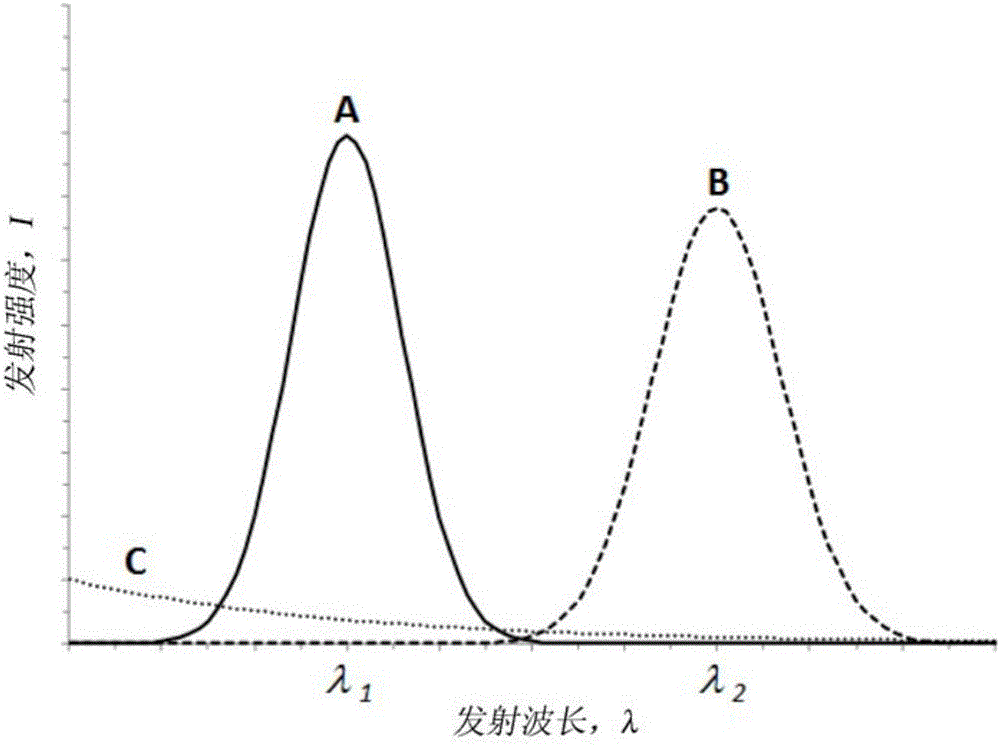Fluorescent tracer for water-soluble films, related methods, and related articles
A tracer, water-insoluble technology, applied in the direction of flexible coverings, detergent compositions, chemical instruments and methods, etc., can solve the problems of impracticality, time-consuming, etc., and achieve the effect of low sensitivity
- Summary
- Abstract
- Description
- Claims
- Application Information
AI Technical Summary
Problems solved by technology
Method used
Image
Examples
example
[0180] Homogeneous Dissolution Test
[0181] A water-soluble polymer composition (e.g., a film or related article, such as a pouch or other container) comprising a fluorophore tracer that is intended to test the release of fluorophores and the uniformity of formation of fluorophores can be tested as follows The ability to dissolve a polymer composition distributed in a dissolution composition. A portion of the water-soluble polymer composition is sampled (eg, a 1 g, 2 g, 5 g, or 10 g sample; or may include an entire article, such as a container made of the water-soluble polymer composition) and diluted in water with enough water to dissolve the water-soluble polymer composition. polymer components and form dissolved compositions. Suitably, a 1%, 2%, 5% or 10% by weight solution of the polymer composition in deionized water is formed. A 2% by weight solution is suitable for PVOH based compositions as it allows timely dissolution of the PVOH polymer component. The dissolved...
example 1
[0183] Example 1: Fluorescent Tracer in PVOH Solution
[0184] Aqueous tracer compositions according to the invention were formed by dissolving a water-soluble fluorophore in a 2% by weight solution of a PVOH copolymer film in deionized water. The fluorophore is a water-soluble disodium disulfonate derivative of stilbene biphenyl, which is commonly used as an optical brightener in powdered detergents (BENETEXOB-M1; available from Mayzo Specialty Chemicals, GA). Fluorophores can be excited with UV light (eg, about 340 nm to about 370 nm) and have a characteristic peak visible fluorescence emission at about 440 nm. Fluorophores were dissolved in solution at levels of 1.8 ppm, 2.0 ppm and 2.2 ppm. Using a BLACK-COMET spectrometer (obtained from StellarNet, FL), the solution with the fluorophore and the control solution without the fluorophore were excited with a 365 nm UV LED and the luminescence was measured in the range of 400 nm to 450 nm. Such as image 3 As shown in , t...
example 2
[0186] Example 2: Fluorescent Tracers and Bitters
[0187] A tracer composition according to the invention is formed by combining a water-insoluble fluorophore with a water-soluble bittering agent in a homogeneous liquid mixture. A mixture of the water-soluble bittering agent denatonium benzoate (25% by weight) in propylene glycol (75% by weight) (BITREX; obtained from Bitrex, Edinburgh, UK) was mixed with the water-insoluble fluorophore 4-methyl-7-(di Ethylamino)coumarin (OPTIBLANCATR; obtained from 3V, Bergamo, Italy) combination with tetrakis(polyethylene glycol)-dodecanyl ether (HO-[C 2 h 4 O] 4 -C 12 h 25 ; "PEG-4-Lauryl Ether" or "Laureth-4") acts as an emulsifier to stabilize an emulsion in water. Fluorophores can be excited with UV light (eg, about 340 nm to about 370 nm) and have a characteristic peak visible fluorescence emission at about 440 nm. As formed, the fluorophore and bittering agent were present in the tracer composition in a predetermined ratio of ...
PUM
 Login to View More
Login to View More Abstract
Description
Claims
Application Information
 Login to View More
Login to View More - R&D
- Intellectual Property
- Life Sciences
- Materials
- Tech Scout
- Unparalleled Data Quality
- Higher Quality Content
- 60% Fewer Hallucinations
Browse by: Latest US Patents, China's latest patents, Technical Efficacy Thesaurus, Application Domain, Technology Topic, Popular Technical Reports.
© 2025 PatSnap. All rights reserved.Legal|Privacy policy|Modern Slavery Act Transparency Statement|Sitemap|About US| Contact US: help@patsnap.com



